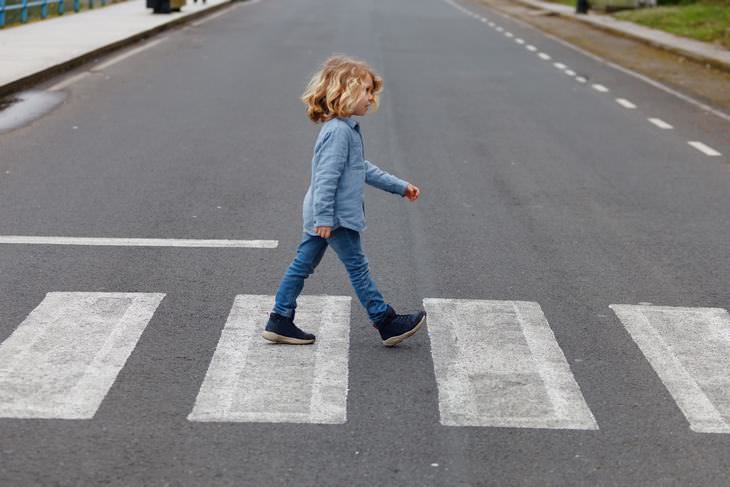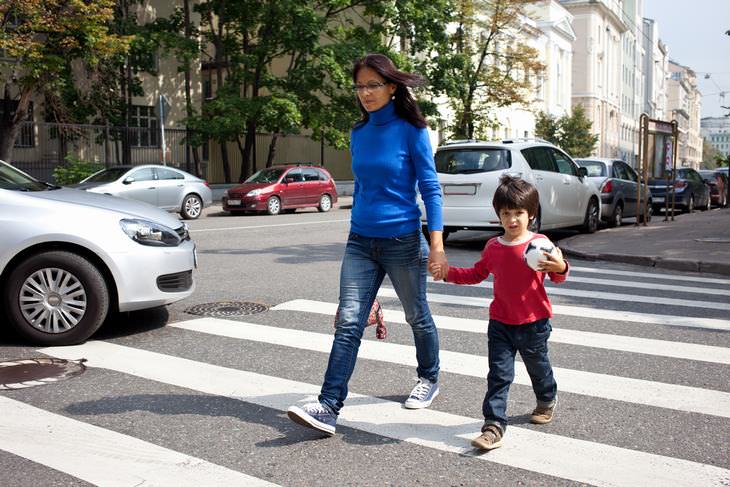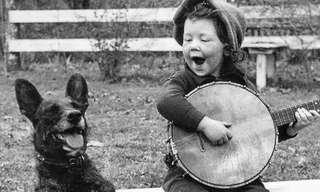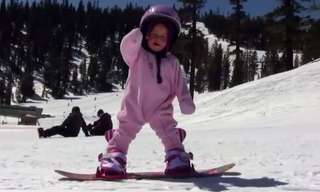

Crossing the street by foot seems like a relatively easy thing to do, for an adult. We look around, analyze the traffic, calculate the time we need to cross the road, wait for the traffic gap, then go. For a child, however, this can be quite a daunting task. Experiments conducted by scientists from the University of Iowa came to the conclusion that kids in their pre-teen years can have difficulties identifying gaps in traffic that are large enough to cross the road safely.
This is because young children may not have developed the necessary motor skills that adults have, allowing them to cross the street right after a car has passed. In fact, Jodie Plumert, professor of the University of Iowa states “Some people might think that younger children are able to perform like adults when crossing the street. Our study shows that this is not necessarily the case on busy roads where traffic doesn’t stop.” So, while most of the children did choose the same gaps in traffic as adults, they weren't as able to time their movement through traffic.
Experts at the university invited children aged 6, 8, 10, 12, and 14 years old, along with a group of adults to participate in the experiment. The children were placed in a simulated 3-D road traffic environment, where each of them had to cross the road with a string of running vehicles. The time between the vehicles differed between 2 to 5 seconds. Each participant had to cross the road 20 times.

The results showed that 6-year-olds were 'struck' by vehicles 8% of the time, 8-year-olds, 6%, 10-year-olds, 5%, 12-year-olds were 'struck' 2% of the time, and kids aged 14 and older had no accidents. This is likely due to the fact that by the time a child has turned 14, they gradually develop the 2 most important skills for safe road-crossing. Firstly, they become better at analyzing the gaps in the traffic, and secondly, they are quicker at stepping onto the street after a car has passed, compared to younger children. So, it is essential that parents or grandparents of younger kids should take extra precautions.
For this reason, scientists firmly believe that it is better to be patient when it comes to letting your child cross the road alone, and wait until they have reached a certain age. Furthermore, teach your child to cross the street and encourage them to choose gaps that are larger than those you would choose for yourself.

Forget Apples! It's an Egg a Day That Keeps the Doc Away...
According to new research, it could actually be an egg a day that keeps the doctor away.Find out more here!

The Funny Side of Parenthood In 14 Images
These funny photos perfectly capture the complexity of being a parent. You can be tired, exasperated, and laughing out loud all at the same time.

Can Probiotics Improve Mental Health? Research Says YES
Studies repeatedly show that probiotics can be a potentially effective treatment for several mental health issues. This is what is currently known on the topic.

Lower Your Blood Pressure Naturally by Eating Watermelon
Watermelon is not only refreshing and delicious on a warm day - it has also been linked to lowering blood pressure levels.

The Funny, Odd and Wacky Things Kids Say - 20 Quotes
Kids can say the funniest, oddest, or the most unintentionally profound things sometimes. Here are 20 hilarious and wholesome examples from real life.

The Link Between Excessive TV Watching & Cognitive Decline
Three recent studies find that the more TV you watch in your 40s to 60s, the greater your risk of brain health issues later in life. What can you do about it?

The Naked Truth Behind Why Men Don't Listen to Women
Have a good look at the 10 biggest reasons why men don't always appear to listen to the women in their lives.

7 Ways to Develop a Child's Executive Functions
What are these executive functions and how can you help your child develop them? You will find all of this in the following guide.

8 Signs It's Time to Sever Ties From a Family Member
Sometimes, it’s important to sever ties with a family member who has been nothing but toxic to you.

What Life Looks Like for British Royal Babies
Discover the cool and surprising facts about the Royal family's babies, the only babies in the world who are given passports at birth.

Hilarious: Before Being a Parent, and AFTER Being One...
Check out this hilarious photo-compilation of parents before and after children.

For a Divorce-Proof Marriage These Tips Are All You Need
Read these words of advice carefully, and write them on your heart!

The Good and Bad White Lies in a Relationship
Four scenarios where it is acceptable to tell a white lie and 4 in which it is not permissible under any circumstances.

Solving 10 Food-Related Problems Some Parents Face
we have gathered 10 common problems and the best solutions to address them, assisting you to get through each family dinner or feeding the baby with ease.

8 Things You’re Doing That Are Spoiling Your Child
The desire to help our children and keep them happy all the time may make them spoiled, so avoid it by following these 8 tips!

How to Talk to Your Children About War & Conflict
As parents, how should you explain to your children about war? Here’s a guide that draws on expert opinions and research to help.

If a Child Lives with Praise, This Is What He'll Learn...
How should we go about raising our children to be strong, independent and certain of themselves?

How to Stop the Cycle of Guilt Between Generations
Dear Parents, guilt-tripping your kids can seriously harm your relationship.

How to Get Your Child to be Serious When Appropriate
How do you establish boundaries and make sure your child is behaving seriously at solemn occasions.

Beautiful: What Kids Should REALLY Be Taught at School!
Children and young teens need to be taught life lessons, that will enable them to be independent and certain, yet respectful.

This Mother's Letter to Her Daughter Touched Me Deeply
There is nothing quite like a mother's love for her daughter, as this heartbreaking letter reveals. Prepare to be moved.

What Happens When Parents Have a Favorite Child?
What Happens When Parents Have a Favorite Child?

10 Timeless Old Family Films You Can Enjoy With Your Kids
These family films may be old, but they can still delight children to this day.

Children of the Past: Historical Photos of Kids Having Fun
19 Nostalgic photos of children having fun playing outside.

Study: The Effect 40 Minutes Have on Children
Let's explore the details of this research and the opinions of other experts in this domain.

Did You Know Grandkids Are Good for Your Health?
In this article, we will introduce the many good ways grandkids influence your life, mind, and body.

Husband Guide: How to Make Your Wife Fall in Love Again
Guide: how to show love again in simple ways and how to make your wife fall in love with you again.

Guide: What to Feed a Baby at Every Age
Not all solid foods are suitable for every stage, which is why we have created a guide to help you feed your baby according to their age.
 5:31
5:31
A Beautiful Old Tale: The Lion and the Mouse.
Share a lovely tale with anyone who loves bedtime stories in classic style!

WARNING: Don't Let Children Play With These Toys
Today there is a large selection of toys, and although they should be fun some may be real life-threatening, such as those on this list,

Remember This 6-Letter Phrase to Mend Passive Aggression
Emotional intelligence experts swear by this one simple 6-phrase to stop passive aggression in its tracks.
 2:32
2:32
Children are Capable of So Much More than We Realize...
After seeing this video, you'll never dismiss kids just because of their age.

These 40 Compliments Will Have a Lasting Effect on a Child
Every child should hear these words every once in a while.

11 Marriage Misconceptions We Should Forget About
these 11 myths demonstrate why a perfect marriage is unrealistic.

5 Tools to Help You Make a Strong, Stable Family
What tools can we use to make our family stronger and less dysfunctional? This article will help you by giving 5 tools to do just that.

10 Worst Things to Say When Talking to Your Grandchildren
In this article, we will look at some of the things you should never say to your grandchildren.
 2:41
2:41
Celebrating a Bond Between Grandmother and Grandson...
This short video is a gentle and beautiful example of loving your family.

These "Harmless" Remarks Can Negatively Impact Children
Avoid saying these seemingly innocent phrases around kids; they confuse them.

A Few Things About Child Obesity We All Need to Know
What causes childhood obesity, why is it getting more common, and what can be done about it?

Couples Passionate About Each Other Practice These Rituals
It's amazing to think what miraculous things can happen between a couple when new positive, behavior patterns are developed.

This Devoted Dad Has Some Words to Share....
Michael Mitchell is a devoted American father who collects tips from various fathers about raising kids, and these are some of his most interesting!

12 Classic Christmas Stories All Children Will Love
Enjoy the holidays with your kids by reading one of these heartwarming Christmas books to your kid.

You'll Appreciate Mothers a Lot More After Reading This
This wonderful little tale will remind you of how tough the occupation of motherhood can really be.

9 Mistakes Parents Make When Vacationing with Children
Trips, especially flights with children, are not simple. To make matters easier, avoid these nine mistakes parents make on family vacations.

5 Vaccinations Every Grandparent Should Get
As a grandparent, you may wonder what vaccinations you need to take to make sure your grandkids are safe.
 2:14
2:14
As a Baby Grows, THIS is What It Will See...
It's no secret that babies see the world differently than the rest of us do, and this video will show you just what their visual development looks like.

How Do We See Our Parents Throughout the Years?
From cradle to middle age, this is how we perceive our parents.


